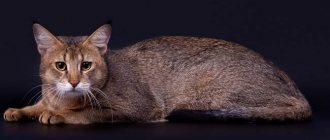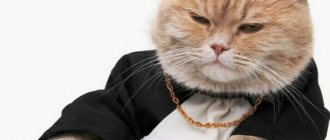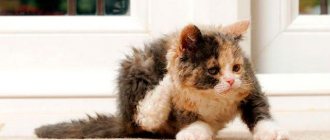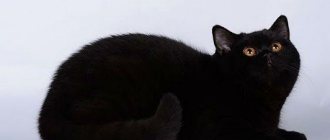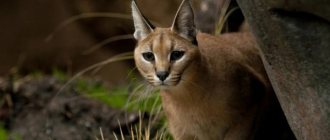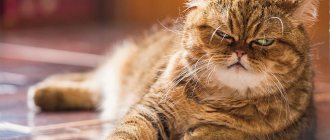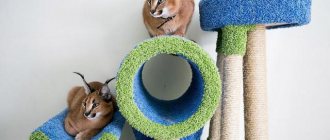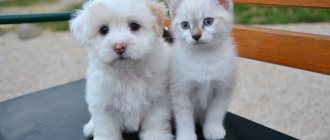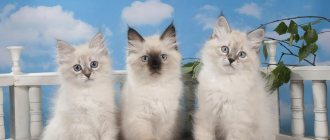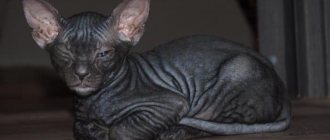Cats have lived with people for over 2,000 years.
It seems that all possible breeds have already been created, because there is nothing difficult in crossing two individuals, the appearance of a special kitten is the appearance of a species. You are wrong! This process is long, forcing representatives from 20 to 50 to be submitted to felinological organizations, accompanied by passports and documents to confirm purebred. Breeders and selectors, without stopping there, continue to create new breeds of cats. We will tell you about them today, collecting 10 new cat breeds in one article.
The essence of cat selection
Selection is the science that studies the creation of new breeds of animals through artificial selection or crossing.
The essence of this teaching is to breed new types of cats, as well as improve the breed characteristics of animals. When crossing individuals using simple methods, both advantages and disadvantages are possible. Thus, with further mating of one breed, the immune abilities of the body may decrease in the offspring. In another species, it is possible that a shortened life span or pathological changes in the activity of the genital organs are possible, which create problems with procreation. For these reasons, feline breeding science is a serious and responsible study. The study of the correct selection of individuals and pairs is considered an interesting work, the optimal results of which bring satisfaction to the scientist and new breeds for lovers of the cat family.
What should you pay attention to?
The color of a cat also plays an important role in animal crossing.
Before starting practical work on breeding a new breed, breeders spend a long time studying the history and characteristics of the genera that will be crossed. Only after the qualities are fully revealed do scientists begin the practical part of selection. Before crossing cats, the breeder needs to clarify points that require increased attention:
- external characteristics of the cat;
- cat suit;
- behavioral characteristics;
- predisposition to pathological processes;
- ability to procreate;
- distinctive features of the animal's hair.
Toyger
Who hasn't dreamed of having their own live tiger? At least on the scale of an ordinary cat. Toyger is the embodiment of this dream! The name itself comes from the words “toy” (toy) and “tiger” (tiger). The “toy tiger” was bred by American felinologist-breeder Judy Sugden on the basis of a Bengal and an ordinary domestic tabby cat.
The toyger has a long body with characteristic tiger stripes, shiny short fur and a soft, friendly character. All these qualities were identified and improved as a result of long selection. The International Feline Association recognized the breed in 2007.
Breeding methods
After clarifying the characteristics of the breed, the breeder chooses a method of breeding cats. This often depends on the desired outcome. There are such types of reproduction as:
Often animals that are closely related are selected for this purpose.
- The most popular option is selection by phenotype. This method, after breeding the offspring, will improve the appearance of the species and optimize the cat’s coat.
- Improved progeny assessment and kitten health are monitored when breeding by genotype.
- Inbreeding is a method of breeding when specialists choose to cross closely related individuals based on family ties. The disadvantage is the strengthening of existing defects in cats. But the development of new imperfections is excluded.
- Genealogical selection is carried out by including the animal's ancestors in the process. Pedigree cats are often used. In this case, the main final factors are the external data of the cat and its totality of properties received from its ancestors.
For such an event, ideal animals with good health are needed.
After selecting a breeding method, experts consider the selection of individuals for the procedure to be an important point. To improve breed qualities, positive selection of cells with a marker gene is significant. For crossing, breeders select exemplary representatives according to all criteria. But due to the use of a small number of individuals in breeding, selected examples of offspring can lose some qualities and genes. Therefore, they often resort to negative selection. At the same time, all cats of the breed without flaws are used for breeding. In this case, both the phenotype and the genotype are strengthened. When there are many shortcomings in a cat species and a small number of individuals, family crossing is used. It helps preserve the gene pool and thanks to this, the best individuals appear. The method is quite slow and the first positive results appear after 5-10 generations.
A professional breeder must understand the correct selection of both individuals and pairs.
It is important to understand that even in this case, unsuccessful results cannot be ruled out. An unprofessional approach to business will provoke the degeneration of the cat breed. Only complete knowledge about selection, study of the breed characteristics of cats, historical origin and patience will lead to a positive result.
How new breeds are created
A new breed of cat or a more advanced type of an existing one is bred by a breeder - a scientist who understands genetics and felinology. His ultimate goal is to obtain animals that have the same genotype and best meet the necessary parameters - breed standards. Breed standards are a set of characteristics of its representative.
To carry out high-quality selection, you need to know the pedigree of the animals selected for breeding. The process of breeding begins with the selection of the first cats.
Suitable cats are crossed, and from their offspring those who have inherited (or perhaps developed) the desired traits are selected for the next stage of breeding. The same is done with the offspring of the second generation. So until you get a representative of the breed that meets all the characteristics in the standard.
Two techniques are used for selection: inbreeding and outbreeding. Inbreeding is the crossing of closely related animals. It is carried out in order to consolidate the necessary qualities and create a stable genotype. Outbreeding is the crossing of animals that have the same characteristics, but which do not have a common ancestor, for 4-6 generations.
In order for a new breed to be recognized by the felinological association, the breeder presents about 20-50 individuals of different sexes and ages. In addition, it is necessary to have documents proving the purebred of the animals.
Selection is a long, costly and largely creative process. Many breeds, like other achievements of human culture, have their own author. Let's talk about some cat breeds bred through careful selection.
Peterbald
Peterbald, or St. Petersburg Sphynx (Peter - “Petersburg”, bald - “bald”) is the result of the work of domestic breeders. Descended from a Siamese-Oriental cat and a Don Sphynx. Officially recognized in 1996. He is considered the most graceful among the existing four Sphynx breeds.
This is a cat who does not like to walk on his own, but loves to communicate. Lack of aggression and sociability are characteristic qualities of both the Peterbald and his ancestors. But what distinguishes him from other Sfixes is his activity, a quality inherited from cats of oriental breeds.
American Curl
American Curls are similar to the most common cats, but with one important difference - their ears have a unique shape. This ear shape is also the result of a spontaneous genetic mutation, which is a natural phenomenon. The ears of American Curl kittens are straight from birth, but after 2-10 days they begin to gradually curl, and by 4 months they acquire their final shape. The tips of their ears become flexible and rounded, and they curl at an angle of 90 to 180 degrees. This looks like a rather strange cat. Now there are many of them all over the world - from the USA they moved to Japan, France, Spain, Russia and other countries. American Curls are playful, friendly, not too whimsical, and easily adapt to changing environments. Since they love to play, they need space and all kinds of toys. But it is better not to have them for families with small children, because children who love to cuddle animals can cause painful injury to the Curl.
Savannah
A hybrid breed of domestic and wild bush cat, the Savannah cat is a savannah cat. In order to breed a large domestic cat with an unusually beautiful “wild” color, breeders crossed the wild Serval with Bengal cats, Ocicats and Orientals. Today, to preserve the purity of the breed, only Savannahs and Servals are used.
Savannah: Wikipedia
What is the breed standard for the Savannah? According to the TICA standard, the Savannah is a large breed with a height of about 60 cm. Its weight can reach 15 kg. It has an elongated body and long legs, which gives it a predatory appearance. The color is characteristic spotted with a predominance of brown, chocolate or brown tones.
Unlike their wild ancestors, savannahs have a calm and docile nature and get along well with humans and other animals. They need a lot of space for constant movement, they need frequent and long walks. For their exceptional devotion to their owner, they can be compared to dogs.
Exotic
Love Persian cats but don't like long hair? Exotic is what you need! Cute face, big eyes and luxurious, thick but short fur. Breeders used short-haired breeds to breed exotics, which were crossed with Persians. This slow, calm and affectionate cat loves to sleep a lot.
The exotic appeared due to a curious accident: its creators wanted to breed an American shorthair cat of new colors and crossed it with a silver Persian. As a result, the opposite happened: instead of a silver American, we got a short-haired Persian.
First mentions
We find the earliest information about cats lacking hair in antiquity, the annals of Egypt and the legends of the ancient Aztecs. There is reason to believe that they are descendants of a extinct breed - the Mexican Hairless, whose representatives finally disappeared in the 19th century. Its characteristic features were:
- long body;
- wedge-shaped head;
- long mustache;
- fur on the back and tail, disappearing in summer;
- amber colored eyes.
There are also known references to the Egyptian sphinx, figurines of which are found in the tombs of the pharaohs. According to legend, they were intermediaries between the world of people and gods, guarding the entrance to the tomb of the pharaohs.
Pixiebob
The cat of this breed is a small domestic lynx. She is affectionate, sociable and active. Pixiebob loves to play, and despite her sometimes threatening appearance as a predator, she is friendly to children.
This breed appeared due to the desire of breeders to get an animal that resembled a domestic lynx. To do this, they crossed domestic cats with wild forest cats. But the task turned out to be difficult: it took a long time to create a pet predator. The pixie bob was officially registered only in 1995, but even today not all felinological organizations recognize this breed.
Sphinx
What are sphinxes known for? The most recognizable external feature of the breed is its hairlessness. “Hairless” cats were bred artificially by fixing a mutation that leads to a complete absence of hair. Unlike other “hairless” breeds (Peterbald, Ukrainian Levkoy), Sphynxes are a middle-aged and stable breed, recognized throughout the world. Due to the lack of hair, cats are suitable for allergy sufferers.
Sphinx: Unsplash
Although their appearance can be somewhat off-putting, Sphynx cats are very affectionate, warm and intelligent cats. They have excellent memory and are easy to train. At the same time, representatives of this breed do not tolerate loneliness well and are very attached to their owners or other animals in the house.
Japanese Bobtail
Japanese bobtails have the same short tails as rabbits; moreover, some cats themselves jump like rabbits, and do not run like self-respecting cats. In medieval Japan, cats with long tails were for some reason considered to bring bad luck; for this reason, their tails were cut off here for a long time, and local selection was aimed at breeding breeds with a minimum length of these same tails. In 1602, the emperor issued a decree “liberating” cats; now they could be street dogs, but by this time they were already born with short tails, just in case. Japanese bobtails have a variety of coat colors, but the most popular cats are Calico or Mike cats, which have a white background with black or reddish uneven loops.
Maine Coon
Another unusual breed of cat is the Maine Coon. They are distinguished from other breeds by their huge size and rugged appearance. The breed originated in North America. Since Maine Coons evolved naturally (without human intervention), they are perfectly adapted to the cold northern climate. The breed got its name from the American state of Maine and the abbreviation of the English word “racoon” (racoon). The Maine Coon is the official dog of the state of Maine.
Maine Coon: Unsplash
What is the Maine Coon breed standard? The World Cat Federation (WCF) has set a standard for Maine Coons. Here are the basic requirements for the breed:
- large muscular body;
- wide neck and chest;
- a long tail;
- square head;
- ears of a characteristic shape.
The average weight of an adult cat reaches 11 kg, and the longest cat in the world, according to the Guinness Book of Records, the Italian Maine Coon Barivel, has grown to a length of 120 cm.
History of appearance
Despite the fact that millions of dollars are spent annually on studying felines, there is still no definite answer - when and how did the cat (K) appear in our homes? The approximate date of the appearance of the domestic K, or rather its ancestor - the steppe - is 140 thousand years ago. Being essentially one of the subspecies of the wild forest cat, the steppe, spotted or African K still lives in the steppe, desert and mountainous regions of Africa, Asia, Transcaucasia, Kazakhstan, and India. Artificially bred cat breeds have the genes of their ancestors - wild K. The word “cat” itself comes from Latin. Derived from “captus” or “captat” - smart, bringing prey.
